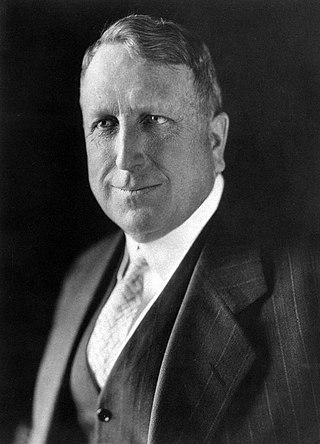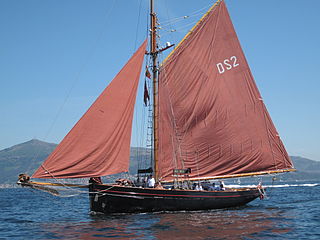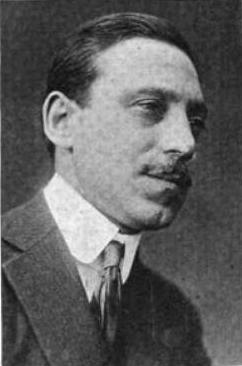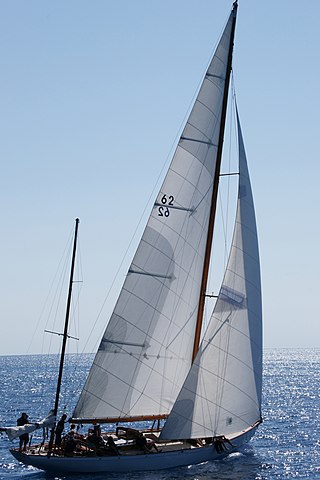
William Randolph Hearst Sr. was an American businessman, newspaper publisher, and politician known for developing the nation's largest newspaper chain and media company, Hearst Communications. His flamboyant methods of yellow journalism influenced the nation's popular media by emphasizing sensationalism and human interest stories. Hearst entered the publishing business in 1887 with Mitchell Trubitt after being given control of The San Francisco Examiner by his wealthy father, Senator George Hearst.

Marion Davies was an American actress, producer, screenwriter, and philanthropist. Educated in a religious convent, Davies fled the school to pursue a career as a chorus girl. As a teenager, she appeared in several Broadway musicals and one film, Runaway Romany (1917). She soon became a featured performer in the Ziegfeld Follies.

Louella Parsons was an American movie columnist and a screenwriter. She was retained by William Randolph Hearst because she had championed Hearst's mistress Marion Davies and subsequently became an influential figure in Hollywood. At her peak, her columns were read by 20 million people in 700 newspapers worldwide.

Jolie Brise is a gaff-rigged pilot cutter built and launched by the Albert Paumelle Yard in Le Havre in 1913 to a design by Alexandre Pâris. After a short career as a pilot boat, owing to steam replacing sail, she became a fishing boat, a racing yacht and a sail training vessel.

The Cat's Meow is a 2001 historical drama film directed by Peter Bogdanovich, and starring Kirsten Dunst, Eddie Izzard, Edward Herrmann, Cary Elwes, Joanna Lumley, Jennifer Tilly, and Ronan Vibert. The screenplay by Steven Peros is based on his 1997 play of the same title, which was inspired by the mysterious death of film mogul Thomas H. Ince that occurred on William Randolph Hearst's yacht during a weekend cruise celebrating Ince's birthday in November 1924. Among those in attendance were Hearst's longtime companion and film actress Marion Davies, fellow actor Charlie Chaplin, writer Elinor Glyn, columnist Louella Parsons, and actress Margaret Livingston. The film provides a speculative assessment on the unclear manner of Ince's death.
Fairey Marine Ltd, latterly known as FBM Marine, was a boat building company based on the River Hamble, Southampton, England. The company was created in the late 1940s by Sir Charles Richard Fairey and Fairey Aviation's managing director, Mr. Chichester-Smith. Both were avid sailing enthusiasts along with Chichester-Smith's good friend and former Olympic yachtsman, Charles Currey.

Daniel Carson Goodman was an American screenwriter and licensed physician.

USS Druid (SP-321) was a private yacht launched 10 February 1902 as Rheclair that was built for Daniel G. Reid. Reid sold the yacht to Senator Nelson W. Aldrich who renamed the yacht Nirvana only just over a year before his death. Aldrich's estate chartered Nirvana to John Wanamaker until it was bought by his son Rodman Wanamaker who used the yacht for cruising until a fire on 14 December 1916, just before a cruise south, severely damaged the vessel. He chartered an alternate vessel for his trip south and, after full repairs, the yacht was sold to Walter W. Dwyer who gave it the name Druid with intentions to sell the yacht to the government in order to finance a shipyard venture in Pensacola, Florida.

The sixth USS Niagara (SP-136), later PY-9, was a United States Navy patrol vessel in commission from 1918 to 1931 and which served during World War I.

Elias Cornelius Benedict was a prominent New York City banker and yachtsman. He specialized in the gas and rubber industries. He was president of the Commercial Acetylene Gas Company and of the Marine Engine Company.

Thomas Harper Ince was an American silent film - era filmmaker and media proprietor. Ince was known as the "Father of the Western" and was responsible for making over 800 films. He revolutionized the motion picture industry by creating the first major Hollywood studio facility and invented movie production by introducing the "assembly line" system of filmmaking. He was the first mogul to build his own film studio dubbed "Inceville" in Palisades Highlands. Ince was also instrumental in developing the role of the producer in motion pictures. Three of his films, The Italian (1915), for which he wrote the screenplay, Hell's Hinges (1916) and Civilization (1916), which he directed, were selected for preservation by the National Film Registry. He later entered into a partnership with D. W. Griffith and Mack Sennett to form the Triangle Motion Picture Company, whose studios are the present-day site of Sony Pictures. He then built a new studio about a mile from Triangle, which is now the site of Culver Studios. Ince's untimely death at the height of his career, after he became severely ill aboard the private yacht of media tycoon William Randolph Hearst, has caused much speculation, although the official cause of his death was heart failure.

USS Owera (SP-167), was an armed yacht that served in the United States Navy as a patrol vessel from 1917 to 1919. The vessel, under the name O-We-Ra, was built as a steam yacht in Leith, Scotland in 1907 for Frederick H. Stevens of Buffalo, New York. In 1915 the yacht was sold to United States Senator Peter G. Gerry of Rhode Island and registered in Providence, Rhode Island as Owera.

Adele was a steel screw steamer that was built in 1906 as a yacht. She was twice commissioned into the Royal Australian Navy (RAN), firstly as HMAS Franklin and later as HMAS Adele. She was wrecked at Port Kembla, New South Wales on 7 May 1943.

The iron-hulled, single-screw steam yacht Utowana was completed in 1883 at Chester, Pennsylvania, by the Delaware River Iron Ship Building and Engine Works for Washington Everett Connor. On sale to Elias Cornelius Benedict the yacht's name was changed to Oneida (1887), then when Benedict bought a new yacht to be named Oneida and sale of the old yacht and conversion to a tow boat the name was changed to Adelante (1913). During Benedict's ownership Oneida was the covert site of an operation on President Grover Cleveland, a friend of Benedict's and frequent guest on the yacht, to remove a cancerous tumor in his mouth.

Shamrock V was the first British yacht to be built to the new J-Class rule. She was commissioned by Sir Thomas Lipton for his fifth America's Cup challenge. Although refitted several times, Shamrock is the only original J-class never to have fallen into dereliction.

Manitou is a 62-foot-long (18.9 m) performance cruising yacht designed and built for racing on the Great Lakes and specifically to win the Chicago-Mackinac Race. It notably served as a presidential yacht for United States president John F. Kennedy and was known as the "Floating White House." Manitou was built in 1937 at the M. M. Davis & Son shipyard in Solomons Island, Maryland. It was Design No. 99 of naval architects Sparkman & Stephens, who built many America's Cup racing yachts.

HMS Evadne was a converted yacht, commissioned as a warship by the Royal Navy during the Second World War. She survives today as the yacht Marala.
MV Star of Malta was a passenger ferry which operated routes from Malta to Sicily in the 1950s and 1960s, notable for its sinking off Malta on 29 July 1955, resulting in the death of one crew member and one passenger. Prior to that, she had a long career under a number of different names.
Camper and Nicholson was a yacht design and manufacturing company based in Gosport, England, for over two hundred years, constructing many significant vessels, such as Gipsy Moth IV and Prince Philip's yacht Bloodhound. Its customers included Thomas Sopwith, William Kissam Vanderbilt II and George Spencer-Churchill, 6th Duke of Marlborough. Its yachts competed in The America's Cup, The Fastnet Race, the Olympics, the Ocean Race and many other yacht races.
















